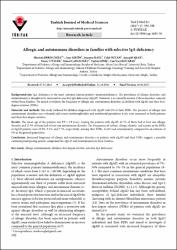Allergic and autoimmune disorders in families with selective IgA deficiency

View/
Date
2017Author
Erkoçoğlu, MustafaMetin, Ayşe
Kaya, Ayşenur
Özcan, Celal
Akan, Ayşegül
Civelek, Ersoy
Kocabaş, Can Naci
Metadata
Show full item recordAbstract
Background/aim: IgA deficiency is the most common human primary immunodeficiency. The prevalence of allergic disorders and autoimmunity is thought to be increased in selective IgA deficiency (sIgAD). However, it is currently unclear if these disorders coincide within these families. We aimed to evaluate the frequency of allergic and autoimmune disorders in children with sIgAD and their first-degree relatives (FDRs). Materials and methods: The study included 81 children diagnosed with sIgAD and 274 of their FDRs. The presence of allergic and autoimmune disorders was evaluated and serum antithyroglobulin and antithyroid peroxidase levels were measured in both patients and their first-degree relatives. Results: The mean age of the patients was 9.9 +/- 3.9 years. Among the patients with sIgAD, 45.7% of them had at least one allergic disorder and 17.3% of them had at least one autoimmune disorder. The frequencies of asthma, allergic rhinitis, and eczema in the FDRs of sIgAD patients were 10.9%, 9.1%, and 7.7%, respectively. Among their FDRs, 14.6% had autoimmunity, compared to an estimate of 5% in the general population. Conclusion: Increased frequency of allergic and autoimmune disorders in patients with sIgAD and their FDRs suggests a possible common predisposing genetic component for sIgAD and autoimmunity in these families.

















